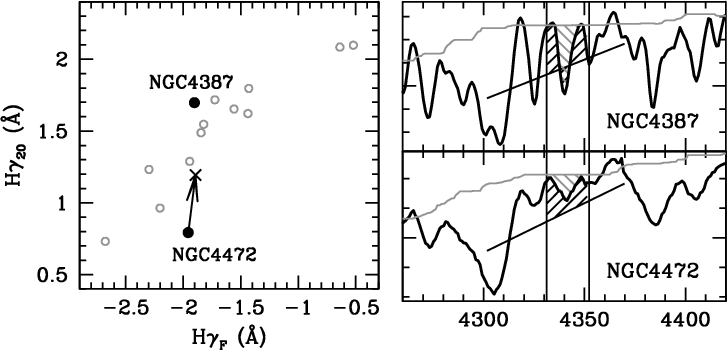
It has been said in the introduction that SED fitting can only yield useful results if the models are as or more precise than the effect on the data of the property to be measured. Historically this was the case only for very limited wavelength ranges in the optical. The solution to this problem has then been to not fit the entire SED, but to define indices, i.e. measure the equivalent widths, for certain absorption features.
In the standard side-band method (Burstein et al. 1984; Faber et al. 1985) a careful analysis leads to the definition of one central and two side bands (a blue and a red). The continuum compared to which the equivalent width is measured is a linear interpolation between the average fluxes found in these two sidebands. Much work has gone into optimizing the set of available indices, as well in terms of coverage, as well as in terms of model precision (e.g. Rose 1984; Worthey et al. 1994; Trager et al. 1998; Tripicco and Bell 1995; Cenarro et al. 2002; Thomas, Maraston, and Korn 2004; Lee et al. 2009b, and references therein).
We are still waiting for standard indices in other wavelengths than the optical, though see Rix et al. (2004), Keel (2006), Maraston et al. (2009), & Chavez et al. (2009), and Lanšon et al. (2008) & Cesetti et al. (2009) for headway into the UV and NIR respectively. These would make the index approach a true multi-wavelength approach.
Rogers et al. (2010a) have attempted to improve on the classical sideband definition by introducing a “boosted median” method. The main feature of this method is that for each side-band only the Lth percentile of the distribution of fluxes is used to determine the flux within the side-band. As this procedure automatically chooses the largest fluxes in the side-band, it will define the pseudo-continuum from those points that are least affected by “secondary” absorption features, i.e. absorption features that are not part of the central band. It thus improves the robustness of the pseudo-continuum if the spectral resolution is high enough to avoid blending of all features. Figure 9 illustrates the difference between the boosted median equivalent width and a standard side-band method for a measurement of Hγ. The sample corresponds to a set of 14 elliptical galaxies in the Virgo cluster observed with a 2–2.4┼ resolution (FWHM) and with high S/N (Yamada et al. 2006).
Index fitting can be considered a special case of SED fitting (for a fitting code see e.g. Graves and Schiavon 2008). It has the advantage of compressing the information available in galaxy spectra into a set of discrete numbers. Much of what is considered secure knowledge in stellar element abundances and age of integrated stellar populations is still largely based on fitting indices (e.g. Trager et al. 2000; Kauffmann et al. 2003a; Thomas et al. 2005; Gallazzi et al. 2008; Graves, Faber, and Schiavon 2009, to cite only a few).
The clear disadvantage of absorption line indices is that some of the information is lost. While indices have been defined with great care to approach the ideal of representing one element species, in practice many small lines interfere in particular in the side-bands. Spectral fitting (Section 4.4) can in principle use more information but it places much higher requirements on model accuracy.
